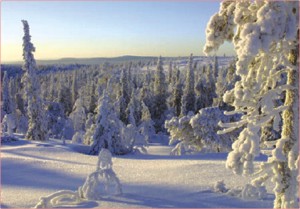Science Feature
Can a Fur Coat Keep a Tree Warm?
By Adrian Cho
 FEW living things seem as passive as trees. When the wind blows, they sway; when the rain falls, they get wet; and when temperatures get hot or cold, so do they. At least that's what scientists have generally assumed. But a controversial study suggests that trees may control the temperature of their leaves, keeping them at a balmy 21.4°C on average regardless of how cold the air gets. FEW living things seem as passive as trees. When the wind blows, they sway; when the rain falls, they get wet; and when temperatures get hot or cold, so do they. At least that's what scientists have generally assumed. But a controversial study suggests that trees may control the temperature of their leaves, keeping them at a balmy 21.4°C on average regardless of how cold the air gets.
The evidence comes from an isotopic analysis of 39 species of trees ranging from Inuvik, Northwest Territories, in Canada to Maricao, Puerto Rico.
The researchers collected their samples close to weather stations, so they had detailed temperature and humidity records for the regions. When they compared the isotope predictions with the weather-station data, the measured ratios in northern latitudes tended to be higher than expected, the team reports tomorrow in Nature. Helliker and Richter found that they could explain the ratios if they assumed that, even in the northernmost regions where the average annual temperature dips to -10°C, the leaves maintain an average temperature of 21.4°C. "I had the only jaw-dropping moment that I've ever had in science," Helliker says.
The leaves do not generate heat and are not made of some superinsulating material, Helliker stresses. Rather, trees in northern regions have probably evolved to clump their leaves together and trap a boundary layer of still air. The boundary layer acts like a blanket, holding in heat and moisture and aiding the tree in its metabolism, he says. In fact, says Helliker, infrared imaging of trees has already shown that their leaves can be warmer than the surrounding air by several degrees, as was reported last year by Christian Körner, a plant ecologist at the University of Basel in Switzerland.
Source : ScienceNOW Daily News
|
